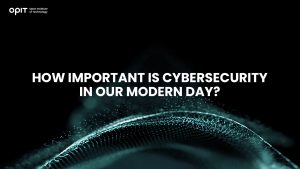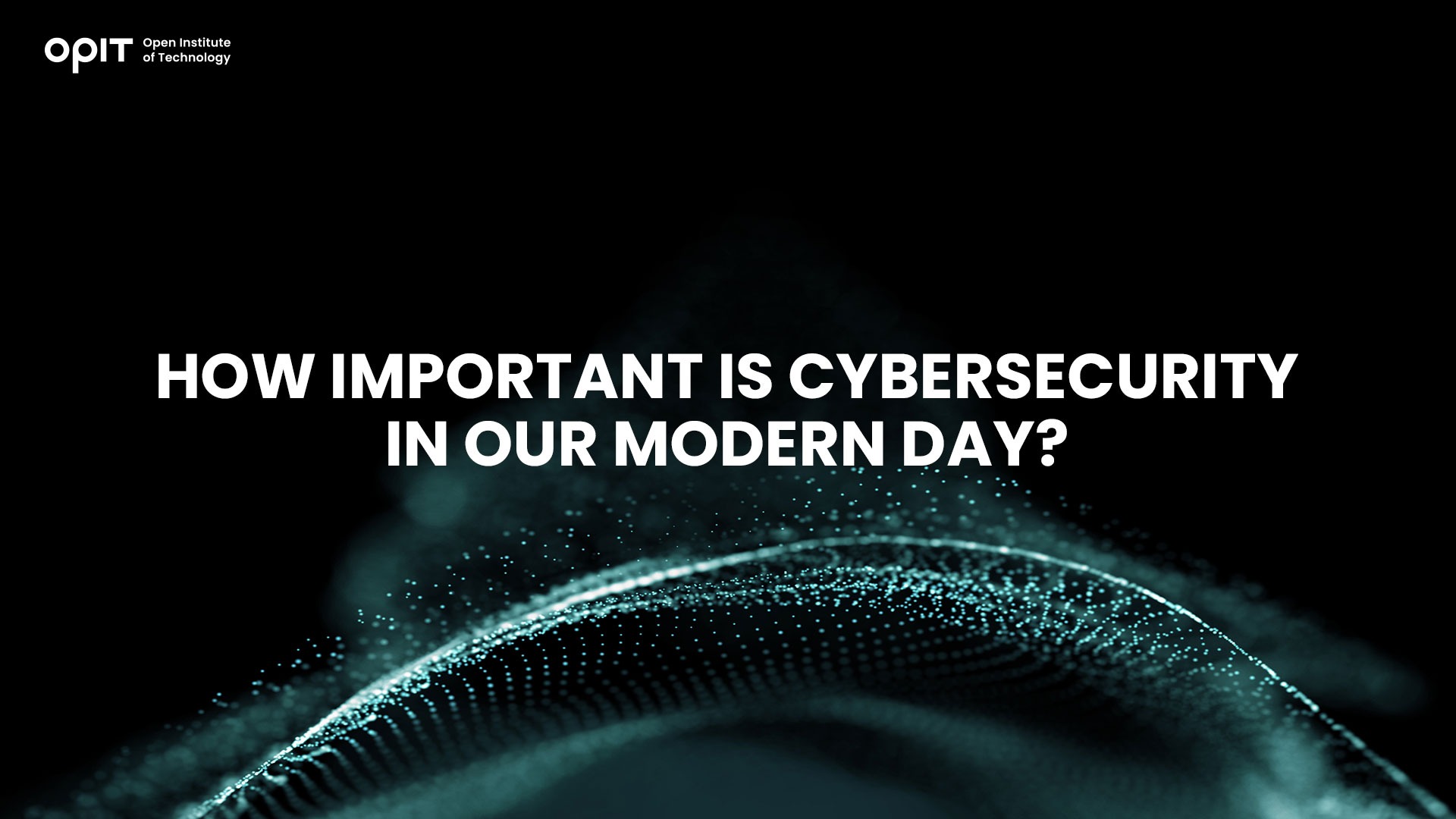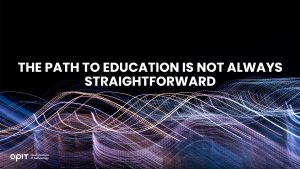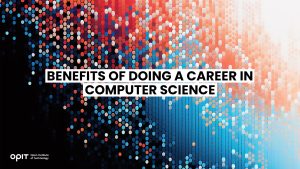

In the digital age, virtually every aspect of people’s lives is connected through digital channels. On the positive side, this allows instant communication and information access, as well as global connectivity. But this connectivity also introduces a myriad of risks, with cybersecurity threats chief among them.
In such an environment, protecting sensitive information and critical infrastructure has never been more crucial. And yet, the cybersecurity industry is short 4 million workers.
That’s why we invited Tom Vazdar, the program chair of the Master in Enterprise Cybersecurity program at the Open Institute of Technology (OPIT), to shed light on cybersecurity’s critical role in safeguarding our interconnected world. Professor Vazdar will also walk us through the Enterprise Cybersecurity Master’s program at OPIT, explaining what makes it stand out among similar programs.
With extensive experience in various industries (like finance and manufacturing) and countless successful cybersecurity strategies, risk management frameworks, and compliance initiatives under his belt, Professor Vazdar is truly the one to consult. His take on the pressing challenges (and solutions) within the cybersecurity field is invaluable for future students and those already in the industry.
The Current State of Cybersecurity
As Professor Vazdar puts it, “We are living in an era where digital transformation is accelerating.” So, it’s not surprising that new trends (and challenges) continue to emerge in the field. Here’s what Professor Vazdar has to say about them.
Cyberattacks Are Increasing
According to the ISACA’s 2023 State of Cybersecurity report, 48% of organizations reported an increase in cyberattacks compared to the year prior. Professor Vazdar says that this primarily has to do with the increasing complexity of cyberthreats. Simply put, organizations can’t keep up with the escalating sophistication of these threats, resulting in their increased frequency.
But there’s another element to this alarming increase in the number of cyberattacks – a lack of transparency. You see, Professor Vazdar claims that many organizations are believed to underreport cyberattacks. Such underreporting might be due to concerns about reputational damage or regulatory consequences. Either way, it’s exceptionally harmful to the industry, as it hinders the ability to collaborate on developing effective countermeasures and strengthening collective cybersecurity defenses.
Cybersecurity Lacks Workers
As previously mentioned, the cybersecurity industry is experiencing a severe staffing challenge. Interestingly, this doesn’t mean the number of cybersecurity professionals is decreasing. It’s quite the opposite, really.
In 2023, the global cybersecurity workforce grew 8.7% to reach 5.5 million people, a record high. And yet, another 4 million professionals are needed to meet the escalating demand for cybersecurity. If there has ever been a stat to prove just how critical cybersecurity is, this undoubtedly does it.
New Technologies Are Constantly Adopted
Artificial intelligence. Machine learning. Cloud computing. Internet of Things. Blockchain technology. These are just some of the technologies Professor Vazdar singles out as transformative forces reshaping cybersecurity.
On the one hand, these technologies have the power to enhance threat detection and cybersecurity response. On the other, they can also introduce new vulnerabilities and threats, such as data poisoning. The worst part? We’ll let Professor Vazdar explain it:
“All of this has come in a really short period of time, and we, as people, are actually struggling to learn about all these new technologies.”
That’s why he emphasizes the need for continual education in the field, as this is the only way to stay ahead of the curve.
Cybersecurity Strategies Are Becoming Proactive and Predictive
Here’s how it used to be in the cybersecurity world, according to Professor Vazdar: A new massive threat would emerge every few years, affecting the whole world. In the aftermath, you would scramble a team together and work tirelessly for a few days to develop a patch or a solution.
As you can imagine, this approach is hardly viable in today’s oversaturated cybersecurity landscape. That’s why “we’re seeing a shift toward more proactive and more predictive security strategies,” as Professor Vazdar puts it.
Cyberpsychology Is Gaining Importance
Cyberpsychology is by no means a new concept. According to Professor Vazdar, this term was first used in 2008 by Professor Zheng Yan. However, its significance has grown exponentially in recent years. This field of study shifts the focus from the cyberthreat to the cyberattacker.
Its goal is to understand what these malicious actors are doing and why. The result? “We, as humans, know how to defend [ourselves].”
According to Professor Vazdar, this is the third (and most important) layer of defense against cyberthreats. The first concerns the physical environment (i.e., the computer and information systems), while the second is a logical layer that “connects everything together.”
No One Is Immune to Cyberthreats
There’s a common misconception that smaller organizations and individuals aren’t “appealing” to hackers and other malicious actors. However, this couldn’t be further from the truth. No one is immune to cyberthreats, as cybercriminals always have something to gain (regardless of the target’s size or perceived importance).
That’s why investing in cybersecurity is crucial, whether you work for a small IT team or a huge company or just use technology in your day-to-day life.
Why Continuous Education Matters in Cybersecurity
There’s no doubt about it – cybersecurity should be a top priority for everyone in the industry and beyond. But as Professor Vazdar has underscored, what was effective in cybersecurity yesterday might not be sufficient today.
That’s why he emphasizes that “it’s important to get educated [now] more than ever.”
After all, there’s a single constant in the ever-changing cybersecurity field – humans as a crucial line of defense. The more people get educated, the more resilient the protection against cyberthreats becomes.
Why Pursue a Master’s Degree in Cybersecurity at OPIT
One of the postgraduate programs offered by OPIT is the Master of Science (MSc) in Enterprise Cybersecurity. This program is fully remote and can be completed in 12 to 18 months. But enough with the logistics – what makes this program the right choice for getting the much-needed education mentioned above?
Given that he practically shaped this program, Professor Vazdar is the best person to ask this question. He shares with us what makes this program uniquely positioned to prepare students for all the cybersecurity challenges he has touched on in this article.
A Comprehensive Curriculum
According to Professor Vazdar, the first thing that sets this program apart is “the curriculum depth and breadth.” This program covers various topics, from cybersecurity fundamentals (the first module) to advanced areas like AI-driven cybersecurity (the second module).
In other words, this program guarantees two things – a solid cybersecurity foundation and a deep dive into specialized topics. This focus makes it ideal for individuals seeking a well-rounded education in corporate cybersecurity, regardless of their previous experience in the field.
A Unique Structure
Unlike most programs in the industry, OPIT’s Enterprise Cybersecurity program doesn’t solely focus on the technical aspects of cybersecurity. But it doesn’t only dive into the managerial aspect of it either. Instead, it gives you just the “right blend of knowledge,” as Professor Vazdar puts it. Thanks to this approach, you can start working immediately after completing the program. After all, you’re all set skill-wise!
Alignment With Industry Certifications
Industry-standard certifications are becoming increasingly important, as most employers prioritize them when hiring new people. If you’re considering a career in cybersecurity, you’ll be happy to know that OPIT’s Enterprise Cybersecurity program is fully aligned with industry certifications like the Certified Information Systems Security Professional (CISSP). As Professor Vazdar puts it, this ensures that OPIT graduates are “not only academically proficient but that they’re also industry-ready.”
It’s also important to note that this program is internationally recognized and ECTS-accredited by the European Agency for Higher Education and Accreditation.
An Emphasis on Practical Applications
The Enterprise Cybersecurity program places a strong emphasis on practical applications. After all, this is the only way for OPIT students to be industry-ready upon graduating. That’s why the entire third module of the program is dedicated to a Capstone project, a hands-on endeavor that also serves as your dissertation.
A Supportive Environment
One of the aspects of studying at OPIT we’re most proud of is our carefully crafted support team. From the class coordinator to the career advisors, everyone at OPIT has a single goal – to help you succeed.
To this end, all the professors in the Enterprise Cybersecurity program (and beyond) are either academics or experienced professionals with plenty of valuable insights “from the forefront of cybersecurity.”
This course includes interactive lessons, live lectures, and private mentoring sessions, ensuring you never feel alone or isolated at OPIT.
Unparalleled Flexibility
One of the primary reasons for choosing online studying is its incredible flexibility. But OPIT takes this aspect to another level. Besides dictating your own study pace, OPIT lets you choose from several elective courses, allowing you to tailor your learning to your interests and career goals. Professor Vazdar singles out the following courses as the most appealing in terms of what this article has discussed:
- Behavioral Cybersecurity
- Secure Software Development
- AI-Driven Forensic Analysis in Cybersecurity
Give Yourself a Competitive Edge With OPIT
OPIT’s Master of Science in Enterprise Cybersecurity program does much more than educate students. It also prepares them for the future, allowing them to become leaders in cybersecurity. As Professor Vazdar puts it, “Our graduate students will be well-equipped to tackle current and future cybersecurity challenges in different sectors.” And given just how quickly these challenges evolve, you can’t really put a price on such preparation (and education).
So, get in touch with our team of experts to give yourself a competitive edge in the dynamic field of cybersecurity.
Related posts

Life is unpredictable. While many of us have specific hopes and expectations of how our futures will turn out, things don’t always go as expected. There are many variables and unexpected incidents that can interfere and force you to alter your plans, and this is particularly true when it comes to education.
For instance, you might have had plans to study a specific subject, but had to deviate from those plans due to unforeseen circumstances. Or you may have had to enter the workforce in an occupation different from the one you sought in an effort to earn an income, a move that may not provide you with the time or opportunity to achieve your desired educational aims.
In short, every individual’s career pathway is different, and very few go exactly as we expect from the outset. Fortunately, even if you experience a few false starts or sudden twists in your pathway, there are always options available to help you get back on track.
The Unpredictable Nature of Education
In theory, the educational process seems simple. You select a course of study that interests you from the vast array of subjects and prospective professions, select the appropriate classes, acquire the knowledge and skills you need to succeed, and then embark on your profession.
In reality, however, as many people know from firsthand experience, the road to education is often far from straightforward. Here are just some of the many challenges that can take your educational path in a completely different direction:
- Life’s Curveballs: As touched on in the introduction, life is impossible to predict. Financial hardships, health issues, and family emergencies are just some of the unfortunate occurrences that might derail even the most perfectly planned educational regime.
- Changing Interests: People’s desires and preferences don’t necessarily stay the same throughout their entire lives. As you grow, learn, and have new experiences, your interests may change, and so, too, may your educational objectives.
- Pressure and Burnout: Some academic paths are particularly challenging, demanding intense levels of study and hard work. This can sometimes prove too much to bear, even for the most resilient students.
- Failures and Setbacks: Conventional education largely builds around tests and examinations, requiring students to demonstrate their competencies repeatedly. It’s a system that doesn’t suit everyone, and test failures can lead to setbacks and delays.
- Inequality: People can be born with very different privileges and levels of access to education. Those in certain parts of the world may find it much more challenging to complete their education path for financial, cultural, or even political reasons.
- Late Bloomers: People develop at different paces. Some may struggle educationally early on in their lives, forcing them to make certain concessions or sacrifices related to their studies, only to find their feet later in life once they’ve entered the world of work.
Whether you’re a late bloomer, have had your educational aspirations delayed by personal problems, desire to learn new skills and try something different, or want to begin a fresh chapter in your professional life, the Open Institute of Technology (OPIT) may be able to help.
Introducing OPIT
OPIT is an online teaching platform, making high-level technological educational programs accessible to all, no matter their age or background. Offering education in fields like computer science, artificial intelligence, and digital business, OPIT provides a curated collection of degrees. In addition, they offer classes taught by world-leading tutors imparting the wisdom and skills students need to achieve their goals and become the tech leaders of tomorrow.
Meanwhile, for those who have had somewhat tumultuous or unpredictable educational paths, OPIT offers the perfect course corrector: the OPIT Foundation Year.
The OPIT Foundation Year
OPIT’s Foundation Year is a Pre-Tertiary Certificate in Information Technology, fully aligned with MQF/EQF Level 4 standards and valued at 60 ECTS credits. Lasting just one year, this program essentially serves as a comprehensive yet accessible springboard towards higher-level education, creating a path towards degrees and careers in dynamic, flexible fields, like computer science and digital business.
Like other OPIT programs, the Foundation Year is delivered entirely online via the OPIT Virtual Learning Environment. Combining live lectures, asynchronous content, and interactive assessments, students enjoy diverse and dynamic study experiences, acquiring core skills like academic writing, mathematics, and computer literacy, and building a bedrock of knowledge and confidence before taking their next steps.
Who Is the Foundation Program For?
The Foundation Program is designed to provide a solid base upon which to build the technological education many students need. It’s the perfect choice for those who are eager and ambitious to enter professions in AI, data science, and computing, but don’t feel that they have the necessary core skills and knowledge needed to dive straight into a degree.
Entry requirements are relatively relaxed in order to allow as many students as possible to enjoy the benefits of this program. With that said, applicants should ideally hold an MQF/EQF Level 3 or equivalent qualification, with the intention of pursuing a bachelor’s degree. A minimum of B2 level of English proficiency is also required, as this is the working and studying language of the institution.
What the Foundation Year Provides
Perhaps you’ve recently graduated, are considering a career change, or finally have the opportunity to return to education after initial delays or unexpected disruptions to your original plans. Either way, the Foundation Year can help you enjoy:
- Greater Self-Confidence: Foundation Year graduates gain the fundamental skills they need to enter degree programs with much more self-belief and assuredness.
- Superior Tech Knowledge: Lasting two terms, this course explores mathematics, academic reading and writing, and provides an introduction to computer hardware and software.
- Foundational Mathematics: Mathematics literacy forms a large part of the study focus for the Foundation Year, helping students feel more comfortable with numbers and formulas.
- Flexible Learning: Unlike more rigid, conventional education environments, OPIT gives you the freedom and flexibility to study at a pace that suits you best, all from the comfort of home.
- Global Community: OPIT is an international institution, with staff and students from all around the world eager to share knowledge, exchange ideas, and help one another.
Take Your Next Steps to Success With the OPIT Foundation Year
If you’re curious about a career in technology or have always wanted to work with AI, data, and computers, but struggled to find the time and opportunities you need to acquire relevant skills and knowledge, the Foundation Program was made for people like you.
It’s the ideal entry point into the exciting world of online education, and the perfect first step towards a prestigious degree from an innovative and increasingly successful institution. Download the brochure to learn more about it, or start your online application, today.

Students today have a broader range of fields of study to choose from than ever before, but with the world becoming increasingly technological and computers increasing in influence and importance, pursuing a career in computer science often proves a smart, strategic choice.
There are numerous benefits and career paths associated with studying and working in computer science, and we’ll be listing just a few of them in this guide.
High Average Salaries
With the rising cost of living in many parts of the world, it’s unsurprising that many students are thinking several decades ahead to determine what level of starting salaries they could obtain in different career fields.
Many are also seeking professions that offer the opportunity for growth and the ability to advance up the ranks over time, thus increasing their salary and their quality of life in the process.
If a strong, stable salary with the opportunity for improved income is one of your top career priorities, computer science should be at or near the top of your list of prospective careers.
According to recent data, computer scientists earn an average of over €65,000 per year, with certain jobs, like IT project leader and data scientist, paying ever higher. Starting salaries are strong, too, with graduates earning anywhere from €46,000 to €60,000, depending on their chosen profession and level of qualifications.
There are similarly high average salaries reported around the world in computer science and related fields such as data science and AI/ML engineering. These numbers are projected to increase in the years to come, pointing to computer science as a way for graduates to get off to the best financial start of any career.
Unrivaled Flexibility
A common problem with some subjects and courses is that they only provide graduates with a narrow set of skills and a similarly narrow range of potential professions to which they can apply those skills.
That’s not the case with computer science. Graduates in this field can enjoy instant access to a remarkably diverse array of career opportunities, with even newer opportunities being created all the time as technology evolves and innovations emerge.
A few of the many industries and roles you might choose to enter in the field of computer science include:
- Healthcare: As a software developer, data analyst, or cybersecurity expert
- Finance: As a fintech engineer, blockchain developer, or security analyst
- Media: As a graphics programmer, AI developer, or game developer
- Education: As an analyst, software developer, or machine learning engineer
Guaranteed Opportunities
Some career paths are more limited than others, with relatively low numbers of opportunities, recurring risks of job loss, or difficulty obtaining employment in the first place.
Again, with computer science, this simply isn’t the case. At a time when 75% of companies plan to embrace AI and other technologies by 2027, and businesses of all sizes and industries are now relying on computers more than ever before, computer science graduates can enjoy almost unbeatable job security.
Opportunities will continue to grow for people with good computing knowledge, whether that be in the obvious fields like software and web development, engineering, and AI development, or more niche sectors.
With so many options, you’re effectively guaranteed a long, rewarding career if you put in the necessary time and effort needed to establish a strong foundation of computing skills.
Rapidly Expanding and Evolving Industries
It’s no secret that the world of technology is a dynamic and fast-moving one. In the past 20 years alone, we’ve seen the proliferation of the internet, the rapid advancement of smartphones and wearable devices, the emergence of AI, and so much more.
In the years ahead, engineers and developers will continue to explore the boundaries of modern technology’s powers and potential, driving new innovations and improvements and opening more exciting job opportunities for those already established and experienced in this field.
Getting into computer science now could therefore provide a solid foundation for a career filled with excitement as you uncover and explore new ways of working with computers in fields as diverse as healthcare, finance, education, entertainment, manufacturing, logistics, and beyond.
Start Your Computer Science Career at OPIT
We’ve discussed some of the many benefits associated with careers in computer science, from the high starting salaries to the rapidly growing array of job options available to graduates. By now, you may be eager to follow this particular career path and take advantage of the wealth of opportunities.
If you’re wondering how to start, the Open Institute of Technology (OPIT) may hold the answers you need. As an exclusively online learning platform, specializing in computer science and digital business, and staffed by some of the world’s leading tech experts, OPIT is producing the tech leaders of tomorrow.
Some of the many advantages of learning with OPIT include:
- Accessible and flexible online education that matches your learning style and schedule
- Heavy focus on real-world applications of the skills you acquire
- An international community of like-minded students from around the globe
- A top team of tutors and lecturers from varying fields and industries
- Progressive assessment of skills and understanding – not constant exams
OPIT offers a small, curated selection of courses for those seeking to gain the technological skills and knowledge to succeed in their chosen areas of expertise. That includes a BSc (Hons) in Computer Science – a six-term program, worth 180 ECTS credits.
Numerous IT industry leaders and experts helped develop this fully accredited undergraduate degree, which is online and accessible to all. Like other OPIT courses, it offers a flexible learning program, with progressive assessments, fast-track options, and the opportunity to be part of a growing community of learners and tutors.
If the benefits of doing a career in computer science interest you, download the OPIT BSc in Computer Science brochure or fill out an online application today and take your first step toward a rewarding and fulfilling profession.
Have questions?
Visit our FAQ page or get in touch with us!
Write us at +39 335 576 0263
Get in touch at hello@opit.com
Talk to one of our Study Advisors
We are international
We can speak in:


